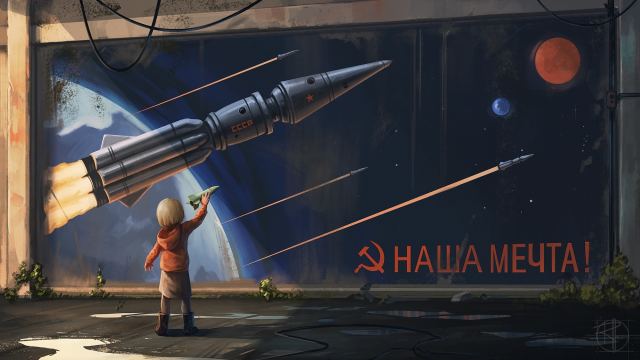The current situation in cosmonautics resonates in an interesting way with what happened half a century ago, when humanity achieved the incredible — stepped on the moon. The participants of the new space race are not so motivated, and the stakes are lower, but it's still interesting to watch this almost friendly competition. Space exploration beyond low Earth orbit has once again become a prestigious goal. Naked Science understands what chances the Russian cosmonautics has to achieve it and why it is so important to strive for the moon.
The beginning of the XXI century was marked by a revival of interest in manned flights beyond low Earth orbit (LEO). The United States decided to reformat the achievements of the Space Shuttle program into something more. America intended to go to Mars, simultaneously repeating the landings on the moon. So the Constellation program was born, which ingloriously perished under the yoke of bureaucracy with budget cuts and was reborn into Artemis. The latter is creaking into being right now.
Meanwhile, the Celestial Empire is catching up. Chinese spacecraft have repeatedly entered orbit around the Moon, made a soft landing on the Earth's satellite, delivered rovers there and sent regolith samples to Earth. The next stages will be the direct preparation for manned missions and their implementation (including landing). With some lag, India is moving in the same direction, having launched a couple of probes and is working on the next ones. Both countries have experienced difficulties, but on the whole they are coping with the serious tasks set quite successfully and are not going to stop.
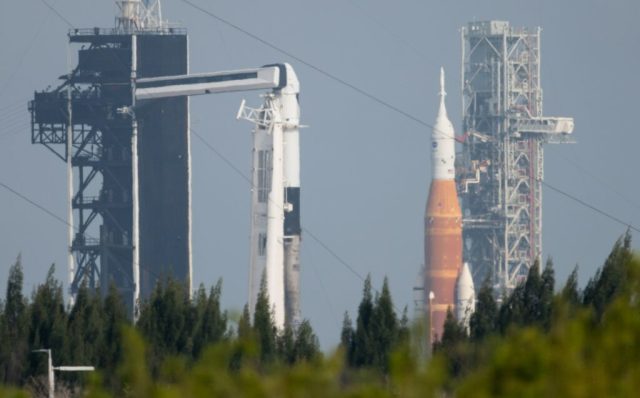
A unique picture of the Kennedy Space Center: SpaceX Falcon 9 with Crew Dragon spacecraft (in the foreground) and SLS with Orion spacecraft (in the background) are installed on the launch tables LC-39A and LC-39B, respectively (April 2022)
Image source: NASA, Joel Kowsky
These are the three main players of the so—called new, or second, lunar race - by analogy with the confrontation between the USSR and the USA in space exploration, which took place in the 1960s and 70s. There are also less respectable participants in it at first glance: Japan, the European Union and, importantly, private structures. Although they have independent lunar exploration programs, as a rule, they act as partners of the leading trinity (mainly the USA).
This time, the United States is going to give even such critical elements as spacesuits for extravehicular activity during the landing to private owners. This situation is not identical to the Apollo program, on which an incalculable number of contractors worked, but the leading role in the development was occupied by government agencies. The peculiarity of the second lunar race is the partial commercialization of progress. A number of tasks of the Artemis program will be performed in the format of a service order: for example, NASA needs to deliver a device to the Moon — commercial companies decide how to do it themselves, fitting the costs into a given budget. The National Aeronautics and Space Administration of the United States itself will participate in the development of the mission only as a consultant. Theoretically, this will allow you not to waste your resources on developing and testing all the details of the lunar program in general. We'll see how it turns out in practice soon.
And what about Russia?
The loss in the epochal contest of two ideological opponents left a noticeable mark in the historical memory of Russians. Disputes about whether the United States really bypassed the USSR, whether Americans were actually on the Moon and whose fault is in all the troubles of Soviet cosmonautics, regularly flare up to this day. The wounded national pride resulted in, albeit not particularly active, but still distinct attempts to catch up.
Over the past two decades, various Russian officials have announced plans to send missions to the moon. Some of them are even being worked on. However, so far none has been implemented. In general terms, as of 2022, the domestic lunar program looks something like this.
Three stages are planned, each of which is being worked out to one degree or another.
- The first ("Sortie") involves sending several automatic research vehicles, both landing and orbital.
- Within the framework of the second ("Outpost"), test unmanned and full-fledged scientific manned flights with the launch of the orbital station, as well as landing on the surface, should take place.
- Well, the third — "Base" — as its name implies, will be marked by the creation of a lunar research habitable base.
- The only mission of a high degree of readiness for today is Luna—25, which, as the head of Roscosmos Dmitry Rogozin reports, is actively and without comments preparing for launch.
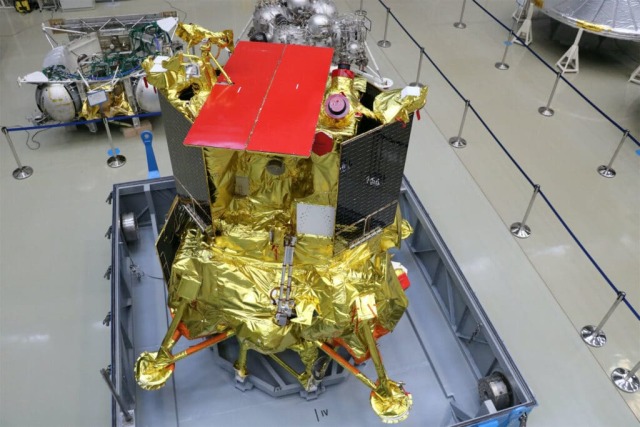
The Luna-25 AMC is preparing to launch at the Lavochkin NGO, June 2022
Image source: Roscosmos
It should be noted right away that, considering the state and prospects of the Russian lunar exploration program below, Naked Science will not make a direct comparison with foreign analogues. At least, because of the inequality of conditions in which the participants of the new space race are located. The budget of Roscosmos is not rubbery, there are problems with the continuity of technologies, as well as economic and political isolation. In addition, it is important to emphasize that there is no complete information about Russian cosmonautics projects in the public domain (due to the general closeness of the industry), so a number of details had to be simply omitted for lack of reliable sources.
What you need to fly to the moon
Strictly speaking, only some kind of rocket is needed (you can even just a passing launch) and a more or less functional device, the development of which will cost a lot of money. That's what the Israeli startup SpaceIL did — and they almost succeeded . But if you approach the matter with serious, "adult" ambitions, then something more will be needed. You can't do without manned missions. We will not think about orbital and surface bases yet, we will focus on the task of leaving an astronaut's footprint in the regolith. By evaluating the parameters of completed and projected flights to a natural satellite of the Earth, we obtain the following.
To implement a lunar manned program, you need: motivation (about it separately and below), a launch vehicle (or several), unmanned orbital and landing vehicles (for exploration and preparatory missions), a spacecraft (with an upper stage), as well as a lander with a return capsule and spacesuits for extravehicular activity on the surface of another a celestial body. At the same time, at least four flights will be required: exploration of the surface and working out the exit to the selenocentric orbit, working out a soft landing, testing the entire bundle of the flight and landing modules, directly disembarking. In fact, there will be even more missions, but the above is an immutable minimum. There should be at least two astronauts on the Moon (so that one helps the other in case of trouble), it is highly desirable to leave another one or a couple in lunar orbit.
Preparatory unmanned missions can be launched on existing missiles, but a new one will be required for landing. To lift 100 kilograms from the Moon (one cosmonaut in a light spacesuit), you need a device with a mass (with fuel and a life support system) of a ton and a half. To deliver it to the moon, a lander weighing about 3 tons is needed. Multiply everything by the minimum number of crew members and even assume that sampling is not expected during the landing — it still comes out already 8-9 tons for two astronauts. Let's take the Soyuz, which was originally conceived specifically for this task, as a model of a migratory ship. In the configuration necessary for a lunar mission, it had a mass of almost 10 tons.
Moving almost 20 thousand kilograms into a selenocentric orbit will "cost" about 50 tons — fuel and the upper stage itself. In total, to launch a lunar landing mission, the required payload capacity of the carrier on the LEO is at least 70 tons. And then only in the case when there is no one in the crew except for two landing astronauts.
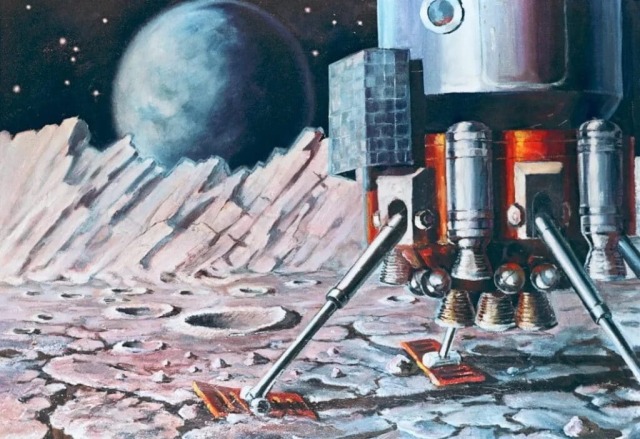
"The moon. The first minutes after landing." Drawing by Alexey Arkhipovich Leonov, Soviet cosmonaut, the first man to go into outer space
Image source: A. A. Leonov, RIA Novosti
What we already have
Let's do a quick inventory.
- A superheavy launch vehicle is not there, development has been suspended, the budget has been redirected in favor of "methane technologies", the result should be expected no earlier than the 2030s.
- Automatic probes — one of the six planned ones is about to fly, the rest are at the stage of manufacturing a structural layout, or even at the stage of documentation development.
- The manned spacecraft is being tested, the first flight is currently scheduled for 2024.
- Landing and take—off modules - the state of development is reliably unknown (presumably, there is not even a draft design).
- Upper stage — the design documentation is being prepared, production is scheduled for "after 2025".
- Spacesuits for activities on the surface of the Moon — there are none, the development status is unknown.
Back in those days, when the possibility of creating superheavy carriers seemed unreal, they came up with an alternative flight scheme to a natural satellite of the Earth — a multi-launch. It implies the withdrawal of all the main elements of the mission on several missiles. But with it there is a problem of an increased risk of failures. The breakdown of the technological process into separate stages, which have a limited period of operation and are acutely dependent on each other, only reduces the overall reliability of the entire event. It's one thing when several launches are used only to refuel a ship launched in one go to the LEO. If something goes wrong, the crew can always return to Earth promptly.
Russian enterprises of the rocket and space industry offer the most difficult option with several Angara launches (sometimes paired with Soyuz) in the absence of a superheavy rocket. The first launch delivers a take-off module to the Moon, another couple brings a flight ship and an upper stage (or two, but then there should be more launches) with a landing module to the LEO, and the astronauts themselves fly on the fourth. A "constructor" is assembled in near-Earth orbit to be sent to the Moon, the crew enters it, and only after that the mission is completed. If the docking goes wrong, then the take-off module disappears (it has a limited waiting period for the expedition), if it fails during the waiting time, and the astronauts have already arrived, they are doomed.
With the existing missiles, too, not everything is smooth. Russia has Soyuz, Proton and Angara, but only the latter is suitable for lunar tasks, and its tests have not yet been completed. Plus, certification for manned flights will be required. The payload capacity of the Soyuz, which has been tested by time and has long been allowed to send people into space (8.2-8.7 tons from Russian cosmodromes), is simply not enough for any element of the mission to the Moon. And the long-suffering Proton cannot launch manned ships (dangerous fuel and questionable reliability), is morally outdated and, despite successful recent launches, still has a reputation for being far from the most trouble-free rocket in the world.
As for the "Angara", even after the completion of the tests, the A5 variant will be able to output slightly larger loads than the "Proton" — 24.5 tons. After some time, a more powerful version of the A5B, designed for 38 tons of payload per LEO, will be put into operation. It turns out that without a superheavy rocket, the Russian lunar program for landing astronauts will require three or four launches of even the most powerful available carriers (so far, four launches are planned). The solution cannot be called optimal, but no others are expected yet.
But what about the preparatory unmanned stage? Here you can rejoice at the "Moon-25" — it looks like it will really happen. But the fate of further missions is still completely unknown. And in general, "The Moon-25" (originally — " The Moon-Globe ") can be safely called the only stage of the current Russian lunar program.
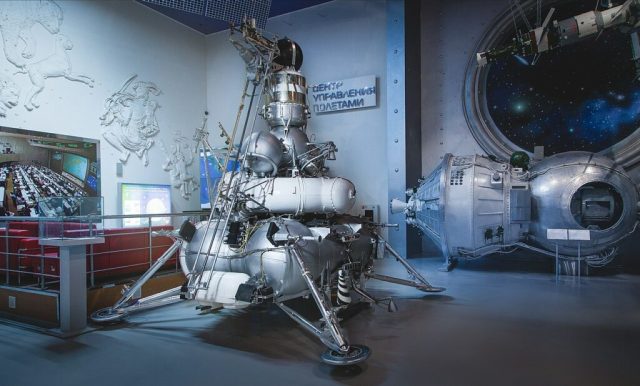
The last Russian mission to the moon, the unmanned Luna-24, was launched almost 46 years ago. She took the soil and brought it back to Earth. So for the first time it was possible to prove the presence of water in the lunar regolith. And over the past quarter of a century, Russian cosmonautics has not been able to fully independently produce a single device designed to work beyond near-Earth orbit. This suggests that the technologies necessary for their development are not being developed at the current level. In the photo: in the left part — the layout of the AMS "Luna-24"
Image source: Cosmonautics Museum
The first domestic mission to a natural satellite of the Earth in almost half a century began to be developed long before serious talks about a full-fledged lunar program. In fact, the entire Russian project of manned flights to the Moon and the construction of a base on it grew around Luna-25. The history of this project dates back almost 25 years, the first developments appeared in the early 2000s, and the device took its current appearance in the drawings in the early 2010s. Since 2008, the mission has changed at least 13 approximate launch dates, two launch vehicles and one spaceport. In other words, this long-term construction can safely compete with MLM "Science" .
Further automatic research stations under the program have every chance to spend comparable time in development. Theoretically, landing on the moon can be done without them, but it would be foolhardy. Before the success of the "Apollo" soft landing on another celestial body, the United States practiced seven times in the framework of the program "Surveyor" (Surveyor). It can be argued that the USSR successfully completed many missions to the surface of the Earth's natural satellite. But the last time it happened was 46 years ago. Since then, several generations of engineers have changed, and the existing technologies, even if not forgotten, are hopelessly outdated. And the problems of the revival of space technology at the modern engineering level were clearly demonstrated by the same United States, trying to use the legendary Rocketdyne F-1 engines for the side boosters of the Space Launch System (SLS) rocket. It turned out even well (a 15% increase in thrust plus a simplification of the design), but it's cheaper and more efficient to do everything from scratch.
In the dry balance today we have:
- the regularly changing appearance of the entire lunar program;
- extremely low stage of readiness of all missions of the first stage, except one;
- missing "in the metal" key elements of the second stage;
- the third stage exists exclusively in the form of careful sketches.
Why go to the moon at all?
This question alone causes almost more controversy than the entire space race of the XX century. It can be answered in different ways depending on personal views, breadth of outlook and foresight. In short, you need to fly in order not to lose the status of a space power and not to fall hopelessly behind the more advanced neighbors on your home planet.
From a scientific point of view, the study of the Earth's natural satellite will answer the most important questions of cosmology. Including how our planet and the entire Solar system were formed. And after the exploration of the Moon, expeditions to Mars will definitely follow. Thanks to this, we will almost certainly get confirmation that life is found everywhere in the universe. And at the same time we will learn a lot about its origin and evolution. All this will move humanity to a completely new level of knowledge of the surrounding world, and it would be good to be among the pioneers of the next scientific revolution. Because those who are the first to receive new knowledge have the most chances to use them usefully.
Technologically, the lunar race, like the whole cosmonautics as a whole, is an ideal frontier of progress. The engineering solutions and developments required for it lie on the verge of the possibilities of human ingenuity. Constant attempts to "deceive physics" force the rocket and space industry to continuously produce new revolutionary products - be it materials, types of equipment or technological processes. Losing these competencies is like death. No country that wants to be on the wave of progress can afford this. And once you have abandoned cosmonautics, you will not be able to return to it cheaply and quickly. And it will never be possible to catch up with the backlog, and with each missed year it will increase exponentially.
Restored television broadcast of the moon landing as part of the Apollo 11 mission / ©NASA, YouTube
Finally, and most importantly, the moon race is a matter of prestige. Not even the fact of any victory in it, but the participation itself. This is an application for the status of an equal player, even if economic conditions do not allow competing at the level of leaders. This is a demonstration of political will, the ability to effectively mobilize the economy, solve non-trivial tasks. In other words, it is a real Olympiad, only for states, not individuals. One can even say that participation (no matter, together with someone or "against") in such unofficial competitions is a matter of self-respect of the nation.
The above three arguments will definitely find their opponents. And this is good, without a palette of free opinions, science and society cannot function normally. With regard to astronautics, the main thing to remember is that today humanity has incredibly detailed maps for a variety of applications, the ability to track climate change on a global scale (that is, predict the weather, plan agriculture and respond to natural disasters in time), as well as broadband communications in all corners of the Earth. The list of positive effects on the daily life of every person from the space race that started in the middle of the XX century can be continued for a very long time. Although it all started with the desire of the military to throw bombs away and the curiosity of scientists who convinced politicians to launch research devices on the missiles they developed for the sake of the prestige of the nation.
Motivation, goal-setting, ideology
Rationalizing the need for flights to the moon through the prospects of science and technology is a noble thing. However, everything is decided by politicians who need to be somehow convinced that it really makes sense to literally throw billions of budget money into the sky. And that's not so bad. A person is a very strange being, if an existential goal is not set before him, he is unlikely to work creatively, efficiently and productively for a long time. And who but politicians know how to set such goals? Will it be a threat to the existence of a species or a nation, or a desire to show the world the realism of the impossible — a question that lies in the plane of the current state ideology.
That is why, defending NASA budgets before the US Senate in 2021, the new head of the agency, Bill Nelson, waved photos taken by a Chinese rover. Like, the Celestial Empire is actually coming on our heels, wake up, what are the funding cuts?! But this is the United States, they have huge funds and a big head start, so the motivation to "hold the position" will be enough. Other players are unlikely to be able to catch up and even more so overtake America, but they will be able to go a similar way, but in their own way and noticeably. Which will also be an undeniable achievement. China and India, apparently, explain their lunar programs in this way: we want to show that we are able to climb to the same peak.
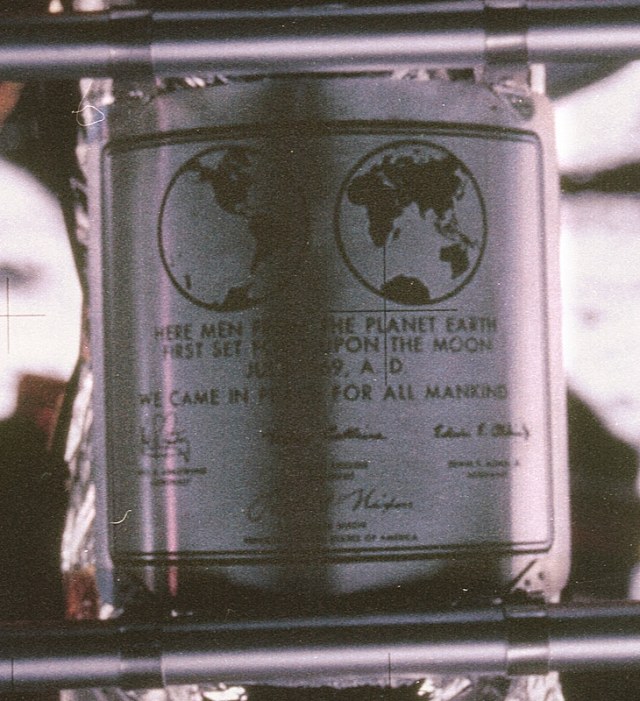
A plaque with an engraving on the ladder of the Apollo 11 lander: "We came in peace for the sake of all mankind"
Image Source: NASA
The trouble is that for some reason Russia does not want to settle for this option, and this leads to a complete lack of motivation. In its current form, the lunar program has barely reached the preparatory stage — Roscosmos has so far placed only two main tenders for the elaboration of technical specifications for a spacesuit, a lunar rover, life support systems for take-off and landing modules ( one in 2019, the second last September). In fact, this is the very initial stage of developing the equipment necessary for missions to the moon. And I would like to think that the cipher of the research work - "Pastoral" — was chosen by the employees of Roscosmos without knowing the meaning of this word . Because otherwise it looks like a kind of deeply philosophical recognition of the futility of all activities in this direction. After all, the moon race cannot be simple and unpretentious, like the life of touching shepherds and shepherdesses.
Instead of a conclusion
Seventy years ago, the world may have been simpler, but the degree of geopolitical tension, frankly speaking, was at a much higher level. That did not prevent humanity from doing the incredible and stepping on another celestial body. The new space race is different: it has more participants and more commercial tasks. But the overall picture looks very similar — the coming decades will show which countries will "move progress". They will be able to explore the Solar System, and the rest will have to be content with the role of spectators. And no past achievements here will save the situation if the groundwork provided by them is not being improved right now.
Undoubtedly, the applied importance of cosmonautics in the modern world is great. But the ability to develop satellites for agriculture, the military-industrial complex or communications will soon become insufficient for the status of a space power. Moreover, the necessary research work to create orbital military and national economic vehicles can no longer move progress as before. Technologies have reached a level where anyone can make a satellite, and the supply in the launch services market is about to exceed demand.
To move on, we need new goals. Even if they look like a repeat of the old ones. This is normal — America has been opened several times. Even the bravest-minded science fiction writers will not be able to predict what the new space race will bring to humanity. It will have a practical impact on everyday life faster than the first one, but still it will not come immediately. And no matter how absurd this idea may look against the background of events taking place in the world, cosmonautics is one of the most important spheres of human activity, which should not be forgotten. If, of course, you think not only about tomorrow, but also about the future of the next generations.
